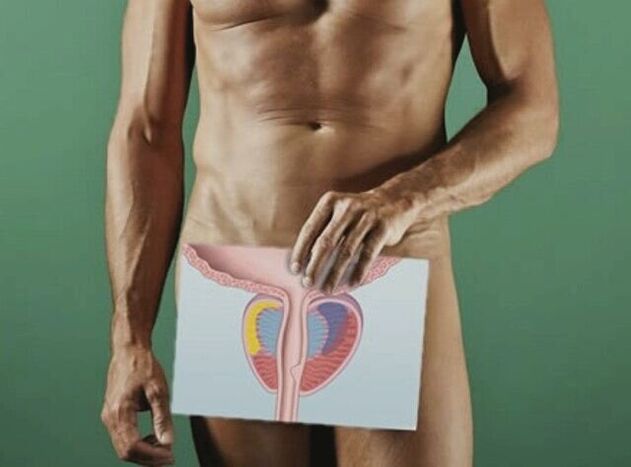
The term "prostatitis (microbial code 10-41)" refers to inflammatory processes in the tissues of the prostate that lead to pain, difficulty urinating, frequent toilet stimuli, and decreased libido. According to various statistics, the disease mainly affects men of reproductive age, ie between twenty-five and fifty years of age. Depending on the characteristics of the syndrome and the degree of damage to the gland, two forms of prostatitis are distinguished - acute and chronic.
According to the MCB coding, a value of 41, 1 is assigned to prostatitis in the chronic form, and encryption 41, 0 is used for the acute form. the primary diagnosis is made by visually examining the patient and studying the medical history. Additional techniques are used for confirmation: ultrasound and laboratory methods.
General characteristics and classification
Every third person in the strong half of humanity knows what prostatitis develops in its various forms, as this disease caused by prostatitis is one of the most common pathologies of the male genitals. The disease is characterized by characteristic symptoms: pain, a burning sensation aggravated by urination, decreased sexual activity, frequent cravings for the toilet.
In men, prostatitis is the result of the defeat of the prostate by infectious agents that enter the tissues of the prostate through the reproductive organs or the systemic circulation. Even causes such as colds or bronchitis can trigger an inflammatory process. This is most often due to favorable factors in the spread of the infection, among which weakened immunity is mentioned above all.
To obtain the average indicators, there is a statistical coding of mkb 10 for prostatitis, which allows an objective assessment of the situation with regard to the prevalence of the male half of the population. Chronic prostatitis mkb 10 code 41. 1, which is associated with a disease lasting six months or more. In addition, the classification of the International Code of ICB 10 xp Prostatitis characterizes this form of the disease as difficult to treat.
The mkb 10 code for acute prostatitis is slightly different - 41, 0. This form of the disease is recognized as a well-treatable therapy and is behind the pronounced symptoms of the disease. There are also 41. 2 codes. The indicator indicates a disease associated with the formation of an abscess in the prostate. It is important to know that a diagnosis of chronic prostatitis suggests that the man be treated at least once every six months and see a specialist regularly.
Predisposing factors
In men, the likelihood of acute and chronic prostatitis increases significantly underlying the negative effects of predisposing factors. The following causes can become a kind of catalyst for inflammatory processes in the tissues of the prostate:
- Stagnation phenomena characterized by decreased blood flow, which occur in the background of a sedentary lifestyle, low sexual activity, overweight.
- Systematic hypothermia of the body caused, for example, by the peculiarities of work.
- Injuries, regardless of their nature and the time elapsed since the injury occurred.
- Infectious viral diseases of the genital organs, including sexually transmitted diseases.
- Infectious and inflammatory diseases of other systems and organs, such as bronchitis, purulent tonsillitis and many others.
As a further predisposing factor, practical medicine also mentions digestive problems, which are manifested in the appearance of systemic constipation. Thus, inadequate access to nutrition can also have an indirect effect on the incidence of prostatitis.
Important! Eliminating or reducing the effects of negative factors in a timely manner is the most sensible and effective way to prevent prostatitis in men.
Clinical picture
Many people probably know what the different forms of prostatitis are. But not everyone knows that the classic signs of this unpleasant disease can vary greatly depending on the stage and form of the pathology:
- Cataract prostatitis. The disease is characterized by the appearance of pain in the perineum, groin, frequent cravings for the toilet.
- Follicular prostatitis. The pain syndrome becomes more intense, difficulty urinating, and a false urge to go to the toilet.
- Parenchymal prostatitis. Severe pain syndrome exacerbated by urination or defecation, often delayed urination, false urge to go to the toilet, high temperature, chills, weakness, fatigue.
The course of chronic prostatitis is accompanied by the onset of almost all of the symptoms listed above, however, the symptoms are becoming worn out. It should be emphasized that the acquisition of a chronic form of the disease is quite rare in the background of exacerbations. Most often, this form of the disease in men develops gradually as a result of inflammatory processes resulting from infectious changes in the tissues of the prostate. The main symptoms are:

- Dysuric syndrome. Against the background of the negative effects of inflammatory processes, the prostate is significantly enlarged, leading to compression of the ureter. This pathology is the main cause of frequent urination stimuli, including false, painful feelings.
- Pain syndrome. The prostate itself is free of nerve endings, and the painful feelings of prostatitis are the result of the spread of inflammatory processes and damage to the nerve fibers near the prostate gland in the pelvic organs.
- Sexual dysfunctions. Diseases of the prostate gland are characterized by the appearance of various sexual disorders. Most men complain of a decrease in the intensity and brightness of the feelings they have during intercourse; a decrease in libido and a lack of erection are possible in the early stages of the disease. Advanced forms of pathology are characterized by impotence.
You should be aware that the development of prostatitis is often accompanied by disorders of the patient’s psycho-emotional background. The man becomes more irritable, depressive states and nervous breakdowns are possible.
Prostatitis has a characteristic clinical picture, which greatly simplifies timely diagnosis. The main diagnostic methods are manual rectal examination by a specialist, ultrasound examination, and collection of urine and prostate secretions for laboratory analysis.
Treatment methods
The method of treating prostatitis, which is the most appropriate in a given clinical case, is determined solely by the treating physician, based on the results of the research, the physiological characteristics of the patient, the form and stage of development of the disease. Most commonly, complex therapy methods are used, including medication, physiotherapy, folk remedies, and dietary correction.
Treatment of chronic form
Chronic prostatitis is a particularly unpleasant disease, with many problems and difficulties to treat, and complete elimination of the disease is almost impossible. However, the use of competent therapy makes it possible to achieve long-term and stable remission, as well as to eliminate the main symptoms of the disease and significantly improve the quality of life. The main treatment methods are:
- Medical treatment. The selection of drugs is carried out according to an individually developed scheme, in particular antibacterial and anti-inflammatory agents are used. The use of analgesics is permitted at an early stage of treatment to relieve pain.
- Physiotherapy. Physiotherapeutic methods, such as laser therapy, magnetotherapy, and electrophoresis, are used in conjunction with drugs to stimulate regeneration processes and increase the effectiveness of the active ingredients of drugs.
- Massage. One of the most effective ways to treat prostatitis, regardless of its form or stage, is prostate massage. The procedure helps to relieve inflammation, eliminate the symptoms of stagnation and pain. Massage is usually performed by a specialist in a health care facility, however, in addition to the mandatory acquisition of medical techniques, you are allowed to perform it yourself at home.
- Immunomodulatory therapy. Therapy for chronic prostatitis involves the mandatory administration of immunomodulatory drugs that increase immune strength and overall body tone. In order to eliminate this unpleasant disease, the selection of drugs should be carried out according to the instructions of the attending physician.
In addition, treatment requires the patient to abandon existing bad habits, correct diet and daily routine. Incorporating a number of products fortified with vitamins and beneficial trace elements into your regular menu will help strengthen your body. Moderate physical activity is also an important measure. Physical activity helps prevent stagnation and normalizes blood and lymph flow.
Important! Treatment of prostatitis should only be performed under the supervision of a specialist. Self-administration of medications or the use of other techniques can lead to negative consequences and worsening of the patient's condition.
Treatment during exacerbation
Competent treatment of acute prostatitis, depending on the timely application of appropriate therapy, allows for complete relief of the disease and normalization of prostate function. It is important to know that this form of the disease tends to become chronic, so treatment should be given when the primary symptoms appear.
Therapy for prostatitis in the acute stage involves the use of drugs with antibacterial and anti-inflammatory properties. In addition, physiotherapy methods, massage and gentle diet can be used. If the disease is underlying the development of purulent abscesses, surgery should be performed to open the capsule, remove the purulent masses, and remove the focus of inflammation.
Possible complications
Lack of treatment for acute and chronic forms of prostatitis can lead to complications. Underlying the inflammatory processes in the form of exacerbation is the risk of developing purulent abscesses in the tissues of the prostate gland, i. e. capsules filled with a kind of purulent contents. The patient's condition deteriorates sharply in this situation, delayed urine output, intense pain syndrome, high fever, chills.
One of the most common complications of chronic prostatitis is the risk of developing inflammatory processes that affect the tissues of the bladder and genitals. In addition, in the vast majority of cases, the disease is accompanied by sexual dysfunction, leading to decreased libido, various disorders of the reproductive system, and in the most severe cases, impotence. It is almost impossible to completely cure such pathologies.
It is important to take timely action to cure the disease, prevent complications, and acquire chronic or advanced prostatitis. It is necessary to consult a specialist to identify the causes of discomfort and prescribe appropriate therapy when the first symptoms of the disease appear. Ignorance of the first alarm bells and failure to take the necessary time leads to serious complications of the disease.
































